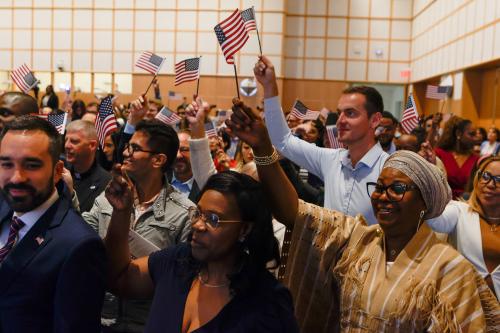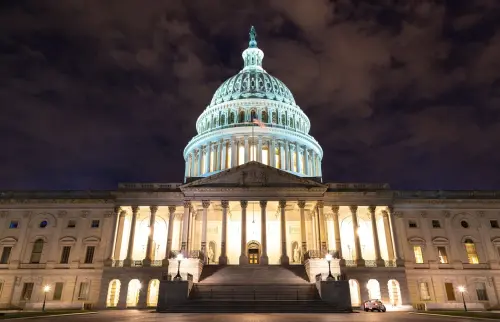America’s foreign-born population registered the smallest growth between 2017 and 2018 than in any year since the onset of the Great Recession, according to recently released U.S. Census Bureau data. At the same time, there is continued dispersal of foreign-born residents, especially those from Asia and the more educated, to small communities and states that were carried by President Trump in the 2016 election.
Some gains for naturalized citizens and big declines for noncitizens
The new statistics from the 2018 American Community Survey show that between 2017 and 2018, the foreign-born population rose by 203,000, well below other years this decade when that number ranged between 400,000 to 1,000,000. It is the lowest annual gain since 2007-2008, the first year of the Great Recession, when there was a small decline in the foreign-born population.

This slow growth is attributable to an absolute decline in the number of noncitizens. In 2018, the U.S. foreign-born population of 44.7 million consisted of 22.6 million naturalized citizens and 22.1 million noncitizens (of which nearly half are estimated to be undocumented). It was only the noncitizen population which registered a loss—478,000 people—between 2017 and 2018, while the naturalized citizen population gained 681,000. (Download Table A.)
While the noncitizen population had shown occasional recent declines, last year’s is by far the largest drop. More than half of this noncitizen decline (296,000 people) is attributable to residents of Latin American origin, but there was also a significant decline (134,000 people) in Asian noncitizens.
Among these noncitizen declines, the U.S. Census Bureau cannot distinguish between those attributable to legal noncitizen residents and undocumented residents. But it is likely that the Trump administration’s actions reducing admission of refugees and its anti-immigrant rhetoric have contributed to fewer inflows and greater outflows of foreign-born residents who are not naturalized citizens.
The foreign-born share of U.S. population still remains the highest since 1910
Despite the recent slowdown, the foreign-born share of the U.S. population in 2018 remained at the previous year’s level of 13.7%—the highest since 1910. This is because the native-born population continues to grow markedly slower than the foreign-born population (4.8% versus 11.9% in 2010-2018). Moreover, at 44.7 million, the nation’s foreign-born population has reached an all-time high.
Still, the foreign-born gains this decade are not likely to reach those of the previous two decades. And if last year’s tepid growth continues, the nation’s increase in foreign-born population during the 2010s could be the lowest since the 1970s.

As Figure 2 indicates, the foreign-born share of the U.S. population dropped to an all-time low of 4.7% in 1970. This occurred after four decades of foreign-born population loss—a consequence of restrictive immigration legislation in the 1920s, the Great Depression, and World War II. This changed after the enactment of the Immigration and Nationality Act of 1965, which abolished restrictive national quotas and effectively opened up immigration from Latin America and Asia. As a result, the foreign-born population rose in subsequent decades, with largest gains between 1990 and 2010.
Foreign-born gains have shifted in other ways since 2010. Prior to that, immigrants from Latin America far outpaced those from other regions. However, beginning in 2010, Asians competed with Latin Americans for the largest gains in the U.S. Among 2018 foreign-born residents, similar numbers of post-2010 migrants reported Asian (40.1%) and Latin American (40.4%) origins. Moreover, the countries contributing most to foreign-born gain during this eight-year period were India and China. While Mexico continues to rank first in total foreign-born population, at 11.2 million, it has sustained a loss of more than 500,000 since 2010. (Download Table B.)
Since 2010, new foreign-born Americans also differ because of their higher level of educational attainment. When looking at the net gains of 2010-2018 foreign-born adults (age 25 and above), 61% were college graduates, compared to 33% among the native-born population. Thus, while foreign-born growth will likely be smaller than in recent decades, it reflects more of what I have called America’s “21st century immigration,” with greater representation from Asia and the more highly educated than in previous decades.
The new destination for immigrants: “Trump states”
Another recent feature of the nation’s foreign-born population is its dispersal to parts of the country where immigrant concentration has been comparatively low. This could impact current political calculations, especially in places that supported President Trump in the 2016 election.
…
Map 1
…
States with High and Low Foreign-Born Concentrations, 2018
Hover over metro areas to view statistics
…
Source: William H. Frey analysis of 2018 American Community Survey
Map 1 categorizes states according to their degree of foreign-born concentration, distinguishing those where foreign-born shares of the population are high (greater than 13.7%), medium (between 5% and 13.7%), and low (below 5%).
The 13 states, including Washington, D.C., in the high category are located largely in the Northeast and West Coast, as well as Texas, Florida, Illinois, Nevada and Hawaii. California leads with a foreign-born share of 27%.
The remaining states, classified as either medium (24 states) or low (14 states), are located in various parts of the rest of the country, with the very lowest concentrations—below 3.5%—in West Virginia, Montana, Mississippi, Wyoming, and Alabama.
While all of this may not seem new, what is occurring this decade is the rapid growth of foreign-born—including those of Asian origin and the highly educated—into states without high and/or long-standing foreign-born concentrations.
As Figure 3 shows, states with high foreign-born concentrations have exhibited smaller foreign-born growth rates since 2010 than those with medium or low foreign-born concentrations: 10.5% versus 16.5% and 14.6%. Twenty-one of the 38 medium- and low-concentration states register foreign-born growth rates greater than the nation, including exceptionally high growth in North and South Dakota (115% and 58%) and rates exceeding 20% in states such as Idaho, Iowa, Kentucky, Nebraska, Pennsylvania, Utah, Tennessee, and West Virginia. (Hover over states on the map to view foreign-born population sizes, shares of total population, and growth rates.)

States with low foreign-born concentrations are also more likely to receive residents of Asian origin, rather than Latin American origin. This is the case for recent migrants in 21 of those states, including Indiana, Iowa, Michigan, Ohio, and Wisconsin. And foreign-born adults are more likely to have college degrees than native-born residents in 12 of the 14 low- concentration states such as Alabama, Louisiana, Missouri, and Ohio.
Because a large share of states without high foreign-born concentrations voted for Trump in 2016 (16 of the 24 medium-concentration states, and 12 of the 14 low-concentration states) it is informative to view how these post-2010 population shifts are impacting these states.

Figure 4 makes plain that the new “21st century immigration” is trending away from states that voted for the 2016 Democratic candidate, Hillary Clinton, toward states that voted for Trump. This was the case for most years during this period, but especially between 2015 and 2018. In fact, over the last year, Clinton states, as a group, registered declines in their foreign-born populations—including substantial declines in New York and Illinois—and more modest declines in California, New Jersey, and Maryland, among other states. Meanwhile, Florida and Texas exhibited significant gains, as did other Trump states including Arizona, Pennsylvania, and Ohio.
These patterns dovetail with a post-2010 dispersion away from metropolitan areas with large foreign-born populations. Map 2 depicts the sizes and growth patterns among the 58 metro areas with foreign-born populations that exceed 100,000. (Hover over metro areas on map to view foreign-born population sizes, shares of total population, and growth rates.)
Map 2
…
Metro areas with largest foreign-born populations, 2018*
Hover over metro areas to view statistics
…
Source: William H. Frey analysis of 2018 American Community Survey
*With foreign-born populations exceeding 100,000
Five metro areas—New York, Los Angeles, Miami, Chicago, and Houston—each with over 1.5 million foreign-born residents, together house 36% of the total U.S. foreign-born population. Yet these areas accrued only 20% of all foreign-born gains for 2010-2018.
The fastest-growing places tend to be smaller areas in different parts of the country. Charlotte, N.C., Columbus, Ohio, Nashville, Tenn., Austin, Texas, and the Florida cities of Jacksonville, Orlando, Cape Coral and North Port-Sarasota led, with 2010-2018 growth rates exceeding 30%.
This dispersal away from large foreign-born populations has become more accentuated recently. In the past year, several large metropolitan areas including New York, Los Angeles, Chicago, and San Francisco registered declines in their foreign-born populations. These declines reflect the downturn in noncitizens from Latin America and Asia discussed above.
The long view on immigration trends
The new American Community Survey statistics show that 2017-2018 foreign-born population growth took a decided dip compared with previous years. They also verify the changing nature of foreign-born growth in the U.S., emphasizing the 21st century patterns of more immigrants from Asia and those with higher educations.
Another important post-2010 shift, despite last year’s downturn, is the dispersion of foreign-born residents to states and metropolitan areas with smaller immigrant footprints. Many of these gains—which serve the role of stemming overall population losses—are occurring in states and communities which supported President Trump in the 2016 election. Will this influx alter the political dynamics of these states, perhaps reshaping local perceptions of immigration and its impact on a community? Or will Trump’s nativist approach continue to find appeal? The 2020 election, and those beyond, will tell us.
Alec Friedhoff created the interactive maps. Cathy Sun and John P. DeWitt of the University of Michigan Population Studies Center provided programming and data preparation assistance.
The Brookings Institution is committed to quality, independence, and impact.
We are supported by a diverse array of funders. In line with our values and policies, each Brookings publication represents the sole views of its author(s).




Commentary
US foreign-born gains are smallest in a decade, except in Trump states
October 2, 2019